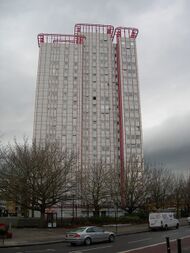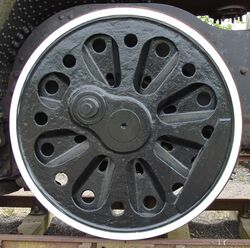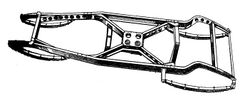Engineering:Lightening holes
Lightening holes are holes in structural components of machines and buildings used by a variety of engineering disciplines to make structures lighter. The edges of the hole may be flanged to increase the rigidity and strength of the component.[1] The holes can be circular, triangular, elliptical, or rectangular and should have rounded edges, but they should never have sharp corners, to avoid the risk of stress risers, and they must not be too close to the edge of a structural component.[2][3]
Usage
Aviation
Lightening holes are often used in the aviation industry. This allows the aircraft to be lightweight as possible, retaining the durability and airworthiness of the aircraft structure.[4][5]
Maritime
Lightening holes have also been used in marine engineering to increase seaworthiness of the vessel.[6][7][8]
Motorsports
Lightening holes became a prominent feature of motor racing in the 1920s and 1930s. Chassis members, suspension components, engine housings and even connecting rods were drilled with a range of holes, of sizes almost as large as the component.
"[The] wisdom of the day was to make everything along the lines of a brick shithouse [...] and then drill holes in the bits to lighten them."—David Kelsey, Lotus Cars[9]
Military
Lightening holes have been used in various military vehicles, aircraft, equipment and weaponry platforms.[citation needed] This allows equipment to be lighter in weight as well as increase the ruggedness and durability.[citation needed] They are usually made by drilling[citation needed] holes, pressed stamping or machining and can also save strategic materials and cost during wartime production.
Architecture

Lightening holes have been used on various architecture designs.[10] During the 1980s and early 1990s, lightening holes were fashionable and somewhat seen as futuristic and were used in the likes of industrial units, car showrooms, shopping precincts, sports centres etc. Parsons House in London is a notable building that uses lightening holes since its renovation in 1988.[11][12] Ringwood Health & Leisure Centre in Hampshire is another notable example.[13][14]
See also
References
- ↑ Fournier, Ron; Fournier, Sue (1989). Sheet Metal Handbook. HPBooks. p. 25. ISBN 9780895867575. https://books.google.com/books?id=ViUmhImu630C&dq=lightening+hole&pg=PA25. Retrieved 2012-06-08.
- ↑ Gerr, Dave (2000). The Elements of Boat Strength: For Builders, Designers, and Owners. International Marine. p. 322. ISBN 9780070231597. https://archive.org/details/elementsofboatst00dave. Retrieved 2012-06-08. "lightening hole."
- ↑ "Chapter 2: Holes - Modeling the Effect of Damage in Composite Structures: Simplified Approaches [Book"]. https://www.oreilly.com/library/view/modeling-the-effect/9781119013211/c02.xhtml.
- ↑ "Sheet metal structure". https://patents.google.com/patent/US2423682A/en.
- ↑ "ANC-18". Flysafe.raa.asn.au. http://flysafe.raa.asn.au/scratchbuilder/ANC18_chapter_4.html. Retrieved 2019-07-14.
- ↑ "Midship constructions". February 4, 2014. https://forshipbuilding.com/ship-construction/midship/.
- ↑ "SEAWORTHINESS ASSIGNMENT CONSTRUCTION". http://www.splashmaritime.com.au/Marops/data/less/Shipk/Shipasig/Seaworthconstassig.htm.
- ↑ "Designing A Ship's Bottom Structure – A General Overview". July 13, 2015. https://www.marineinsight.com/naval-architecture/design-of-ships-bottom-structure/.
- ↑ Ludvigsen, Karl (2010). Colin Chapman: Inside the Innovator. Haynes Publishing. p. 150. ISBN 978-1-84425-413-2.
- ↑ "INNOVATIONS - Metalstroi Stoianov & Georgiev Ltd. – Manufacturing and assembling metal constructions". Metalstroi-s-g.com. http://metalstroi-s-g.com/en/company/innovations. Retrieved 2019-07-14.
- ↑ "Peter Bell Architects: Peter Bell Architects". http://www.peterbellarchitects.co.uk/parsons.html.
- ↑ "Parsons House, London - Building #2077". http://www.skyscrapernews.com/buildings.php?id=2077.
- ↑ "Website Builder | Simple & Easy To Use | UK2". Pgparchitects.co.uk. http://www.pgparchitects.co.uk/. Retrieved 2019-07-14.
- ↑ "Photo" (JPG). https://c2.staticflickr.com/4/3742/9661374941_aef51b49d3_b.jpg.
External links
- Tests Of Beams Having Webs With Large Circular Lightening Holes, by L. Ross Levin, National Advisory Committee for Aeronautics
- The Strength And Stiffness Of Shear Webs With And Without Lightening Holes, by Paul Kuhn, National Advisory Committee for Aeronautics
- The Strength And Stiffness Of Shear Webs With Round Lightening Holes Having 45° Flanges, by Paul Kuhn, National Advisory Committee for Aeronautics
 |




